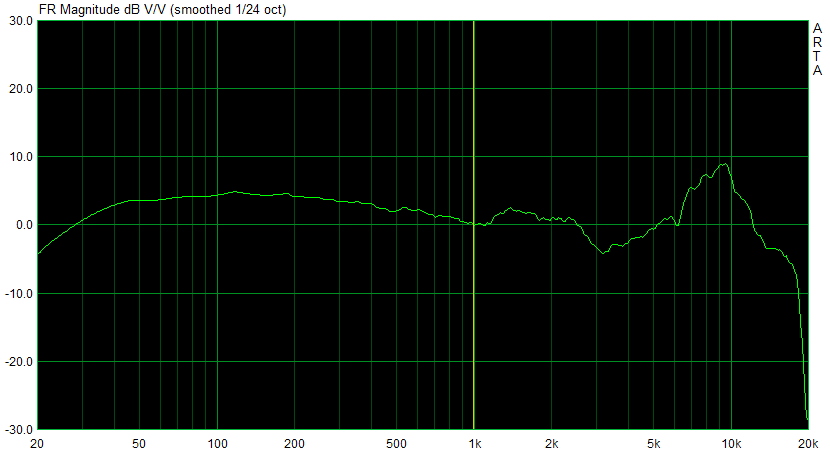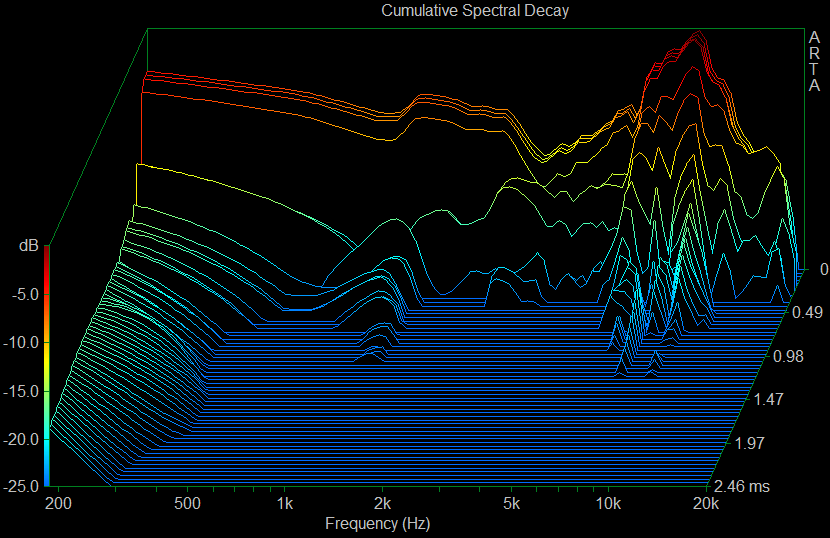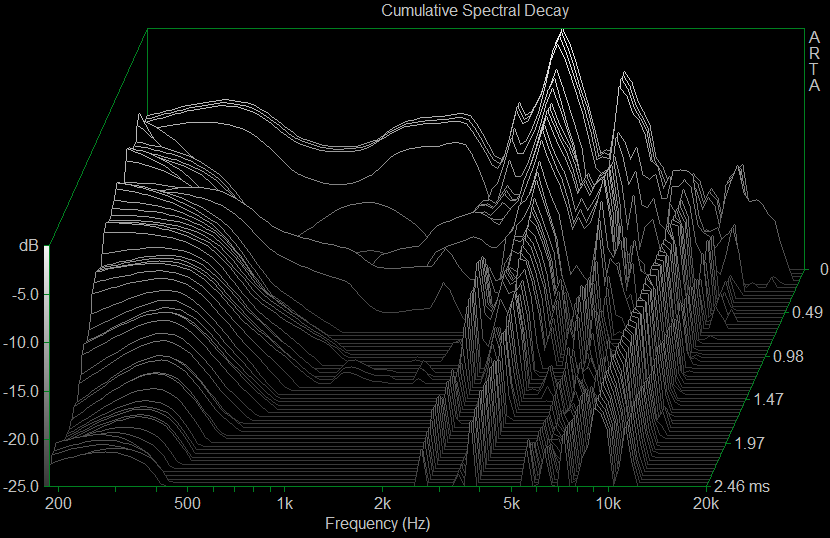Measurement of the frequency curve
Let us now turn to the announced new measurement, which has already been threatened in the foreword. Although I have still standardized the frequency curve at 1 KHz to 0 dB, on the one hand it is possible to evaluate the overall course with all encores and frequency waste and on the other hand not quite loses the comparison possibility to previous measurements. But it's still different, because the smoothing is gone to half an octave. All of this looks clearly "more hibbeliger", of course, but also fits much better with reality. Because one thing is also clear: it does not exist, the ideal curve. Especially since in the case of the Amiron Home it would not even be wanted.
We see a light V, i.e. the elevation in the bass range, as well as the Beyer-typical peak in the high-frequency range. This is so intentional and can bring you to the white glow with other models of the manufacturer. Not so the Amiron Home, whose very pleasing and very smart overemphasis in the super high tone meets especially subtle strings and percussion elements. The peak also starts at the Amiron Home clearly above the Sibilant, so that the human voice is not affected by it. I'll say something about it right away, because the normal bathtub looks different and sounds different.

Cumulative Spectral Decay (CSD)
The curves of the spectral decay analysis provide further very useful information about the performance of the installed drivers. This analysis is based on the frequency response diagram shown above, but also contains the element Time and now shows as a 3D graphic ("waterfall") very clearly how the frequency response develops over time after the input signal has been stopped. In colloquial terms, such a thing is also called "end" or "swingout".
Normally, the driver should also stop as quickly as possible after the input signal has been omitted. However, some frequencies (or even entire frequency ranges) will always subside slowly and then continue to appear in this chart as longer-lasting frequencies on the timeline. This is a good way to see where the driver might be particularly "squeaming" or where resonances may even occur and disturb the overall picture.

The picture at the Amiron Home is good, but you can also see very nice where the sounding starts. The needles of the light tweeter whip in the super high tone between approx. 7 and 9.5 KHz continue here as well and in fact stay in the ear a little longer. In relation to the reached level, however, this behavior can already be put into perspective, because at 1 ms the last beep has disappeared again, only the upper bass and the foundation underneath may still roll out something. The next tests of simpler headphones will show how things are much worse, and I don't want to deprive you of an example of an 80-euro headset:

What you can and even have to certify to the Amiron Home is an almost grandiose settling behavior, because even the driest impulse comes to the point immediately and from the hip without setting on. The drivers are extremely fixed and in sum nothing drags on. The fidelity to impulse swell swells must be praised, even if there are even better copies in the price range. But Kevin-Klaus Normalhörer will not be able to distinguish this any more. So there is a real hatz, which not only reads in a nutty way, but also sounds the same.
Subjective listening experience
Let's also test subjectively what you have in the original on your ear. I have been using the Amiron Home very intensively for a long time, which should take the wind out of the sails even the most hardened one-game fanatics, because there are well over 200 hours of operation coming together.
Bass
Test the lowest bass in the subcontraoctave (16.4 Hz to 32.7 Hz) with a recording of Bach's Toccata and Fugue in D minor (19 and 25 Hz) and the Festival Overture 1812 by Tchaikovsky (10 Hz and 12.5 Hz). The same applies to the lower ranges of the contraoctothe (32.7 to 65.4 Hz). The big bass drum (kick drum), which in the U-music is a welcome companion and usually on approx. 55 to 60 Hz, this assessment will then be rounded off.
The bass is good, very deep and never even partially weak, but without appearing pointlessly loud or over-present. He's just there, point. The subcontraoctave is the cellar-like icing, even if certain tiny details threaten to sink into the warm fullness. The advantage of the found tuning is that both dust-dry and velvety grumbling contents are reproduced equally well. And then you are amazed again and again, because you suddenly hear impurities in the bass, which do not sound to the head, but are already on the material and which a normal headphones lubricate smoothly and thus politely obscures. The Amiron Home is of course not a puncher, but still no softie and above all one thing: fundamentally honest.
The upper bass up to 150 Hz, in which also the Great Octave (65.4 to 130.8 Hz) is located, houses the basic language frequency of the male voice and decides very strongly on the true-to-life reproduction of male vocals.
This area sounds absolutely natural and selective, which makes the voice reproduction of male voices an experience of the other dimension. These vocals are almost unlimited in volume and seem very natural. The entire bass range up to the upper bass plays confidently, warmly and also concisely, without brutally pushing away the upper middles or the high tone. What the Tesla drivers really can do is play a true-to-life rendition of a very wide-band sound carpet, where no area tries to dispose of the other. The instruments are in no way inferior to the vocals and in gaming you have the usual battle noise as a fat ear-stapping, but without sacrificing the rest with it. I haven't had a gaming headset, including the MMX 300, which plays from the bottom up in a similarly confident way.
Frequency range
The lower middles (also basic tone range) are approx. 150 to 400 Hz. Together with the already mentioned upper bass, this area plays a very important role for the subjectively perceived heat or bass. Fullness of the sound. The basic language frequency of female voices can be found in this area.
Female vocals are in no way inferior to the males and if you look at the curve of the measurement, you also know why. The slight emphasis up to the 1-KHz mark gives the Amiron Home a subjectively felt warmth that is not only pleasant, but also helps to ensure that you do not give up unnerved even after hours of hearing. Let's call it balm for the ears, because the bidding is at the forefront in this price range and you beat the T 90 by lengths, which is something you want to say. The dissolution is also free from any criticism.
The upper mids between 400 Hz and about two KHz contain a mark at a KHz, which is still considered a reference for many measurements. Unfortunately, this is often noticeable with cheaper devices, as manufacturers often try to overemphasize this frequency. This area does not play an insignificant role in gaming either, and balanced playback contributes significantly to good spatial resolution.
In contrast to the DT 1990 Pro, the Amiron Home rather snuggles into the armchair here, instead of squeecuting my ears hysterically in the style of a sound detective. No, none of this is analytical, it shouldn't actually be in the home hi-fi area. It's all there anyway, and in an acoustic emergency you hear the same tonal nonsense, as with studio headphones, just not as a succinct slap, but as a well-meaning clue. The location is good, although the vote does not allow for an overly broad stage. Even the MMX 300 is positioned much further. Even the depth staggering is not as extreme as one might expect.
You have to listen more carefully (and longer) before this supposed disadvantage even appears to be a clever move. Because you are not sitting in the orchestra, but right behind the conductor in row one. The location of individual instruments (or sources) is even clearer in the end, because it is more natural. For gaming, the stage is more than sufficient and still better than almost anything you get up to 150 euros. But it is certainly not what Chantal-Cheyenne dreams of for 600 euros. I don't really want to hear music any other way, only when i'm playing I prefer to bet on the big Nubert nuPro and subwoofer again, where of course the bar is already hanging high.
High-pitched range
Between two and about 3.5 KHz, human hearing is most sensitive, especially since this area of the lower heights is responsible for the good overtone reproduction of the human voice. This frequency range is crucial for the recognition of a voice or instrument; in this context, one also speaks of the respective timbre.
The small peak at approx. 1.5 KHz never even disturbs at the beginning and even the small dent at 3.5 KHz sounds almost as intended, because it colors a lot in the overtone very warm and soft. All vocals and instruments remain natural and are staged very confidently. It is the rounding off of a sonic interpretation that could hardly be more relaxed and nonchalant.
The middle heights (3.5 to six KHz) decide on the sound or failure of the speech reproduction as a whole, because the S- and hissing (Sibilants) fall into this range. The upper heights then reach up to approx. ten KHz to move into the super high tone.
From now on, everything is back to its usual course. The Sibilants are shaped very cleanly without chewing off your ear. But that's exactly what the sound engineers have given sugar to their infamous monkey (rum-soaked). The Peak Beyer gets a new entry in his summit book, even if an alternative route has been taken this time. Blow-out sounds, hissing-wiping jazz whisls and other sound highs rise to the highest form and even a quietly whirling violin still finds its way into the hearing centre of the astonished listener. Very subdued recorded tones are brought forward a little more by the peak, but then at least stick, because they are not washed away by the low tone into the tonal ocean. This peak is almost the lifeline for even too quiet sounds, which one actually does not want to miss after a while in this interpretation.

Summary and conclusion
With the Amiron Home, Beyerdynamic has succeeded in creating a rather velvety-soft and very warmtuned hi-fi all-headphone, which does not afford any real weaknesses and can even set new accents compared to the already good T 90. In the end, this is simply relaxed and casual armchair cuddling in the homely high-priced ambience of the Beyer-Hotel with an honestly priced feel-good guarantee. Nothing is cheaply gilded or applied too thickly, but the entire object has been stylishly adapted to the zeitgeist. Although not everyone likes the interpretation, it's so laid-back that you never really question it.
Well, what could hurt would be quite the price. But lordships – no less euros are invested every one or two years in graphics cards, whose half-life still loosely undercuts that of banana ice cream at noon in Dubai at the top of the Burj al Arab. Here, however, you get a 5-year warranty product with a long-term factor and an almost unlimited availability of spare parts and accessories. If you add the purchase price proportionally to the years that you can have real pleasure here, then there is almost nothing cheaper. And best of all, headphones never slow down even with new games and music, but even mature with age.































